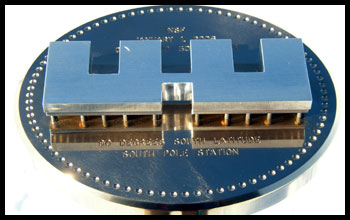Multimedia Gallery
Official South Pole marker 2006
The official South Pole marker for 2006. On January 1st of every year, a new brass marker is placed at 90 degrees south to designate the location of the geographic South Pole. The ice sheet where the South Pole is located moves approximately 7 meters a year. Previous years' markers are left standing for a few years, illustrating the movement of the ice sheet. Participants wintering at the South Pole design and create the unique markers each year. Stephen Parshley, a scientist who wintered at the Pole in 2005, designed the 2006 marker. It is a 5-inch diameter brass base mounted with an aluminum elevated state design. The 86 dimples on the perimeter of the base represent the members of the 2005 winter-over South Pole crew.
The National Science Foundation runs the U.S. Antarctic Program (USAP). In addition to maintaining three U.S. research stations on the continent, USAP supports research projects in an array of scientific disciplines, including for example, aeronomy and astrophysics, biology and medicine, geology and geophysics, glaciology, and ocean and climate systems. Outreach such as the Antarctic Artists and Writers program and education programs are also supported. For more information about USAP, visit the program's website Here. (Date of Image: Jan. 1, 2006)
Credit: Joe Tarnow, National Science Foundation
Images and other media in the National Science Foundation Multimedia Gallery are available for use in print and electronic material by NSF employees, members of the media, university staff, teachers and the general public. All media in the gallery are intended for personal, educational and nonprofit/non-commercial use only.
Images credited to the National Science Foundation, a federal agency, are in the public domain. The images were created by employees of the United States Government as part of their official duties or prepared by contractors as "works for hire" for NSF. You may freely use NSF-credited images and, at your discretion, credit NSF with a "Courtesy: National Science Foundation" notation.
Additional information about general usage can be found in Conditions.
Also Available:
Download the high-resolution JPG version of the image. (1.6 MB)
Use your mouse to right-click (Mac users may need to Ctrl-click) the link above and choose the option that will save the file or target to your computer.

